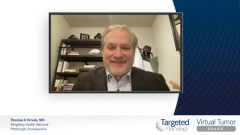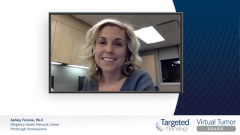
Case 3: Managing Treatment-Associated Hypertension in Patients With Ovarian Cancer
Thomas C. Krivak, MD, leads a discussion on initiating antihypertensive therapy for patients with ovarian cancer who develop treatment-associated hypertension.
Thomas C. Krivak, MD: Again, this patient was treated with carbo/Taxol [carboplatin/paclitaxel] with bevacizumab [Avastin]. She has a response and then added on to olaparib [Lynparza] with bevacizumab for her last 6 weeks. She was given bevacizumab and then added olaparib 6 weeks after completion of her chemotherapy. We talked about how we would manage this patient and we’ve talked about HRD [homologous recombination deficiency] versus HRP [homologous recombination proficiency]. And this patient is going to benefit from the PAOLA regimen but as well as could benefit from PRIMA if we wanted to do switch. Most of us have agreed that combination olaparib with bevacizumab would be appropriate, as well as consideration for neoadjuvant chemotherapy.
Talking about hypertension with respect to some of these medications as well as combination medications, I would say that utilizing bevacizumab for the last 15 years, we’ve increased our management of hypertension as a GYN [gynecologist] oncologist. Typically, we will see these folks, I use a beta blocker quite often. I usually tell them about 10% to 20% of patients will develop hypertension. It seems like a lot of patients are already on hypertensive medications and when we start them, we try to make sure they see their PCP [primary care physician]. Obviously, with this, Ashley and Cecelia are right, get these patients to exercise and get them on a good diet to help potentially try to mitigate these. But what do you guys think about hypertension with the combination as well as potentially just with single agent niraparib [Zejula] and help manage these patients? John?
John K. Chan, MD: With the antihypertensive therapy, fortunately we don’t see that much of it with the niraparib. Clearly, we’re accustomed to handling patients with antihypertensive therapies due to our extensive knowledge of use with antivascular drug or Avastin. Monitoring their blood pressures at home and also starting early in terms of treating these patients with their antihypertensive medicines or adding to their antihypertensive drugs and comanaging them with our colleagues, with cardiology and internal medicine. Those are all important things that we can do to prevent these patients from getting any exacerbations associated with their hypertension and allow them to continue to get the benefit of the PARPs.
Cecelia H. Boardman, MD: I usually will partner with the primary care provider and if the patient doesn’t have a good relationship with primary care, we’ve got a wonderful relationship with our cardiology group. And they’re very helpful to us in terms of managing significant hypertension associated with bevacizumab. Also, in my former job, I had a nephrologist that I worked very closely with and he was the author of the JCO [Journal of Clinical Oncology] article on clonidine and bevacizumab associated hypertension. Clonidine was, for a long time, my go-to drug. I don’t use beta blockers very often, but ultimately there’s not a recommended antihypertensive to treat hypertension associated with bevacizumab. You develop comfort with a particular class of drug or a particular agent. I don’t dose interrupt very often for bevacizumab. I will try to manage their hypertension very aggressively and not hold their bevacizumab unless they are in the very severe range. We try to be very proactive about blood pressure monitoring and blood pressure maintenance.
Thomas C. Krivak, MD: Ashley, how about seeing patients in the clinic, do you see this very often or do the patients ever say anything like, “Hey, my blood pressure is so high.” It seems like we have a pretty good relationship with some PCPs as well, but what do you think?
Ashley Farione, PA-C: Because I work with a couple other physicians in the office, too, sometimes some of them will manage their blood pressure, the hypertension. A lot of our patients though when they’re coming to us already have underlying comorbidities. They’re set up with cardiology. They see their PCP frequently. For some of the physicians, if they don’t have a lot of underlying comorbidities and they are starting to have hypertension related to the Avastin they may start them on a first-line medication. I know 1 of my old physicians I used to work with, she would do a hydrochlorothiazide. But, if it starts to get to the point where they’re managing their blood pressure or they’re checking it a home and it’s still increasing despite medication, then we start to have them see their PCP or their cardiologist, and then they take it from there and manage it. But we do encourage them to do the blood pressure logs at home. They call into the office; they give us updates with it and let us know how things are going. And when they come into the office, if it’s too high that day, then we just hold treatment. But, for the most part, we do some of it in the office but a lot of the times we have that great relationship with the PCP or the cardiologist and they take over the management of it.
Thomas C. Krivak, MD: Excellent. Very good. To conclude, again, we’ve talked about niraparib, olaparib, olaparib/bevacizumab. Any pearls? I know that you’ve all managed many patients on niraparib as well as olaparib/bevacizumab. How about clinical pearls to share with looking at combination olaparib/bevacizumab for this maintenance strategy for folks out there that are managing these patients? Cecelia?
Cecelia H. Boardman, MD: It’s interesting because I have a patient who lives remotely and her primary therapy is being delivered by medical oncology. And she’s a young woman, germline BRCA positive but had significant volume of disease at presentation. And she’s on olaparib/bevacizumab and she developed significant anemia, and the team taking care of her didn’t appreciate that the anemia might be due to the olaparib. And they were working her up for iron deficiency and starting iron infusion but hadn’t thought about, again, looking at the olaparib dose and potentially dose interruption and dose modification. It’s important to remember that this regimen can cause anemia. It can cause mild increases in serum creatinine. It can cause increases in blood pressure. And, generally, the increase in creatinine, 1.3, 1.4 range, I take note of it, but in patients with creatinine clearance issues, there’s also a dose mod [modification] for olaparib as well if, I think if the creatinine clearance is less than 35. Being aware of the ability to again make these drugs tolerable and mitigate toxicity through dose interruption, dose modification is important.
Thomas C. Krivak, MD: John?
John K. Chan, MD: I agree. When you use combinations, we just have to have the understanding that more treatment, more drugs equals more toxicity. And that’s why we’re seeing large, double the discontinuation rate in the patients who underwent the PAOLA study to the patients who underwent the PRIMA study with single agent niraparib. To keep these patients on this combination, allow them to continue to get the benefit of the bevacizumab, it’s important to closely monitor their adverse effects so that we can help them through it, whether it’s with dose modifications, dose holds, and also with slow reintroducing these drugs so that the patients can get that 37-month benefit associated with the PAOLA.
Thomas C. Krivak, MD: The only pearl that I would add is that if they do have toxicity, to me I think PARP is the most important combination. Try to make sure that they find a way to get on a PARP, whether it’s olaparib or niraparib. You brought up the anemia if you need to switch and to go niraparib. Don’t give up on and say I’m not going to do anything, stop the medication, do this, switch to another medication. I wouldn’t say just we’ve had it for 14 months; we don’t need it for another 10 months to finish out your 2 years. I would try to find a way to have that patient get 2 to 3 years of maintenance therapy. That would be the biggest thing that I would add.
Transcript Edited for Clarity













































